There are historical costumers who like making corsets, and there are those who don’t. I am definitely in the ‘likes making corsets’ group.
I love making corsets – I love the fitting, I love the precision, I love the scope for playing with really lux fabrics that you couldn’t afford for a full garment. I love that they don’t have sleeves, and I love that even the fanciest corset is usually pretty minimalist – the trim on finished garments is really where I get bogged down. Most of all, I love them for what they do to your overall look. A corset is a foundation garment; it is the foundation to your outfit. Without the right corset, your outfit just won’t look right.
I’ve made many corsets over the years, mostly from my tried and true personal corset pattern, which does 1870s-1890s well. However, I always love trying new patterns, and there is one pattern I’ve long meant to try. Well, not one pattern, one specific style of corset. There are a whole swathe of 1890s corsets made from nearly identical patterns, with no gussets at bust or waist, and long princess seams running up and down the body.

Corset, Worcester Corset Company (American, 1864—1950) ca. 1893, American, cotton, metal, bone, Metropolitan Museum of Art
Salen’s Corsets: Historical Patterns & Techniques has a pattern for this exact style of corse. The late 1880s corset pattern from Corsets & Crinolines (the corset the pattern is based on is also shown in Corsets: Historical Patterns & Techniques) is another example of the type. I’ve also studied a couple of 1890s corsets with very similar shapes and makes. Based on these examples, I amalgamated a pattern that had all the characteristics I wanted.

Late 1880s corset pattern from Norah Waugh’s Corsets & Crinolines
Along with the princess seams, my pattern has separate top-stitched boning channels, a slight sweetheart neckline, and cording across the bust – all typical of corset styles from 1890-1900.

Corset, 1890s, French, silk, Metropolitan Museum of Art
My corset is made from black silk satin (recycled from a vintage obi).
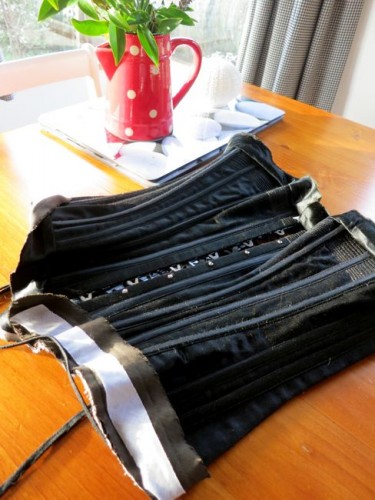
I’ve lined it with a fantastic baroque inspired quilting cotton. Isn’t it fabulous?
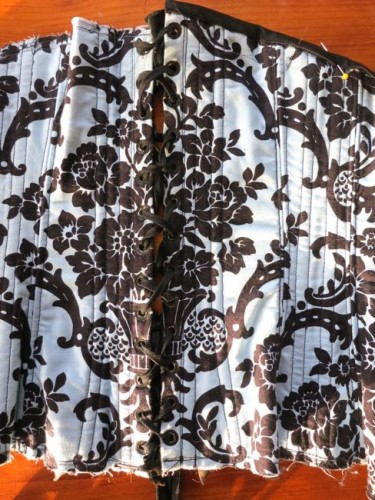
Due to fabric constraints, I didn’t match the lining pattern all the way around the corset, but I did manage a full vase of flowers centred on the back lacing, a full vase centred on the front lacing, and full vases on the side pieces.
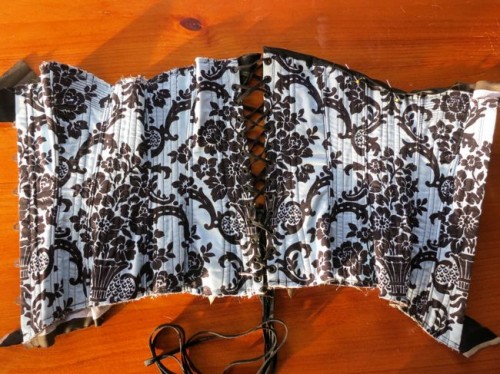
Plus this perfect bit of matching at the side-front seam. Go me!
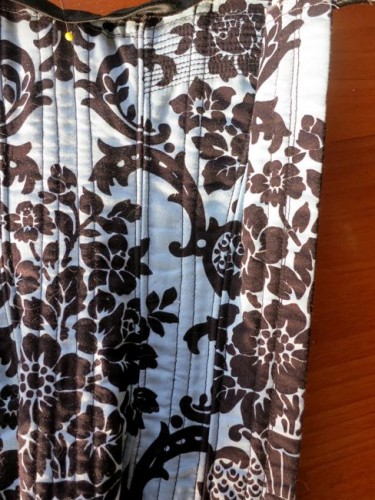
Sadly, the patterned cotton lining isn’t period-accurate, but corset linings is one place where historical accuracy doesn’t bug me. It doesn’t affect the wear and shape of the corset in any way, it’s completely invisible when the corset is worn, and it makes the corset more fun to wear and sew.
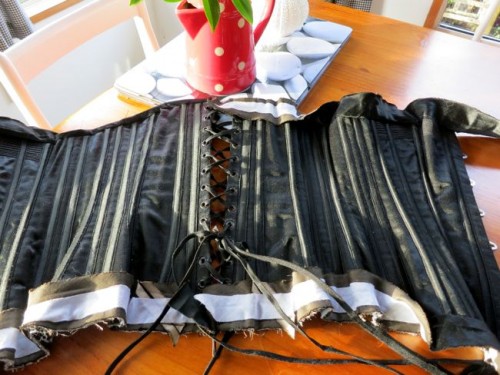
Because I’m trialling the pattern and don’t expect it to be perfect, I’m using this corset as an opportunity to try some variants in my corsetmaking techniques. They are mostly things that students have asked me about when making corsets (“hey, what happens if I do it this way?”). There is no better way to answer those types of questions than to try myself, find out, and know with certainty.
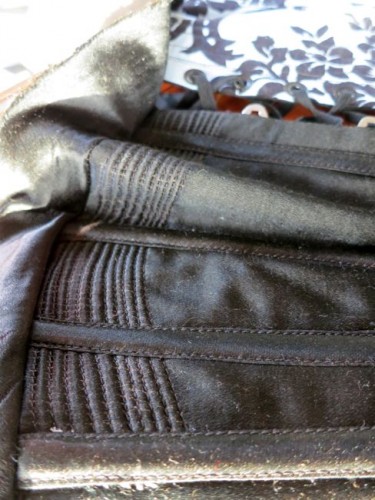
In terms of design, my pattern is extremely close to the Corsets & Crinolines pattern (and the Salen pattern, and the two corsets I studied (really, they are so similar!). Based on corsets I studied, I’ve placed my cording right along the upper edge of the corset – rather than lower on the bust, as in the Corsets & Crinolines pattern. The choice was primarily aesthetic based – I simply thought it looked better.
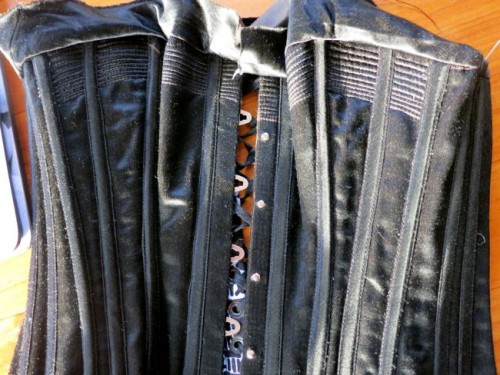
As you can see, it’s almost done! I’m spending this weekend re-doing and sewing the top and bottom binding, and trying to source lace trim for it, though I won’t be heartbroken if I can’t find the right lace.

Gorgeous!!!
The comment about corsets being minimalist of course led me to start thinking about exceptions – of which this is probably the fanciest I’ve seen!
http://collections.vam.ac.uk/item/O166863/wedding-corset-unknown/
Thank you!
I just KNEW someone was going to have to go looking for a non-minimalist corset! I still maintain that by the standards of ca 1900 that is still a very minimalist garment.
I’m working on a corset from this same pattern right now!
Probably not the same pattern, as my corset is from my own personal pattern, but I’m looking forward to seeing the your version of the Waugh corset. 🙂
I really want to make a corset, got all the bits except for the space to set up my machine (and no, I’m not hand-sewing a corset, my hands would object).
Fingers crossed that next week I get to play with my supplies and machine, and have room on the lounge floor to cut out.
Fingers crossed for you too! What type of corset were you planning?
That is gorgeous! I’m playing Mabel in a production of The Pirates of Penzance right now which they’ve set in 1890 and for which I’m actually going to be corseted (!!! This theatre almost never bothers with the correct underpinnings, I’m so pleased about this one!), and I’ve been SO tempted to make myself a new corset, as my old all-purpose “Victorian” one is getting old… this post is not helping me to fight that temptation!
Thank you! Remember that the top finished one isn’t mine – just my inspiration. How fun to play Mabel (I love the Pirates of Penzance), and I am so pleased that they are corseting. It really adds to the costume and the overall effect. Go on, give in, make yourself a new corset!
Oh, I know – your not-quite-finished one is gorgeous as well 🙂 If I weren’t currently without a job and therefore very low on disposable income I probably would give in and make a new one, but I don’t think I can justify the money now. Maybe for the next show? 🙂
I’m in the third group…to afraid to try it!
Any chance there is a corsetmaking class in your area? Because once you learn some tricks, they aren’t hard, and it’s fantastic to be able to make your own – cheaper, you get exactly the shape you want, and they really fit properly. I really encourage you to try!
Looks amazing! Can’t wait to see it modelled on someone. Are you making it to fit your measurements?
Thanks Theresa! Yes, it’s me sized, so I’m afraid it will be a bit big for you. Most of my frocks are me sized, so it makes most sense to make corsets that are that size. And it’s certainly easiest to check for proper fit adjustments on my own body.
I’m in a strange mix of the two groups — I love the actual construction of the corset and of course I love wearing it, but I hate making mockups for corsets, hate trying to fit them, ugh!
I have to admit that I don’t love the fittings and mockups part nearly as much as the rest, but I’ve found that years of making corsets has made me pretty good at guessing how a pattern is going to fit me and a lot of other body types, cutting down hugely on mockups and fitting. And making lots of mockups has made me dislike them less.
Oh, I did the same pattern (Waugh) for this HSF challenge, even in black. Althoug I used contrasting thread for the piping and flossing.
Big brains think alike… 😉
Well, I’m not actually using the Waugh pattern, but it will be similar! I look forward to seeing your version!
I love the look of cording on period undergarments! And I wonder what those different techniques are, but seeing as I’ve never made a corset per se, I don’t think I could see the difference easily… Good luck with this project!
This looks exciting—I love the lining! And the cording, gonna have to go check that out some more…
OK, so if you don’t mind a tangentially-related question, I’ve been trying to figure out the difference in corset silhouette between 1860s and 1880s… I have two patterns that are 1860s(ish, at least in the one case) but the era I’m most likely to end up trying to re-create is early 1880s and I’m not sure how strikingly inaccurate the silhouette would be—or how to alter it to be more correct for the time. I keep finding lots of information on bustles, though…
Thanks! Cording is fantastic, and if you look at period corsets, very widely used. It really helps to create the proper silhouette and shaping.
In terms of the difference between 1860s and 1880s corsets, 1860s corsets tend to be shorter, with a focus on a full bust and hips, and a rounded waist, with little emphasis on waist reduction. They tend to be softer and less heavily boned than 1880s corsets – there are 1850s and 60s examples that are simply quilted or corded with no boning at all. 1880s corsets tend to be longer and stiffer, creating a very sculpted torso silhouette, with lifted bust, compressed waist, and a fairly tight fit over the hips (though the hips and bust are still where the extra flesh from the waist is moved to). May I ask which patterns you have? There aren’t many good commercial patterns, so its usually worth your time to size up the patterns from Corsets to Crinolines, for example, rather than attempting to alter and modify a less-than-ideal commercial pattern.
Thanks for the reply! I have Butterick 4254, which I gather is VERY costumy (but the first mockup I did was OK in terms of fit/sizing, needing just a couple of tweaks. It would need to be quite a bit longer at the bottom for the later period, I think. And the waist shape is probably not right… but neither is MY waist shape, so I’m not really sure how to approach that; I blogged my first mockup a couple of months back) and Simplicity 2890. I confess, I don’t really NEED a high degree of historical accuracy, but I’d like to know where I’m getting it wrong if I’m going to. 😉
ralphpink.comfestiveattyre.comgeheugenvannederland.nlI know you don’t need historical accuracy, but a really well fitted corset that gives you the right shape for the outfit you want is going to end up being historically accurate in lots of respects anyway, so you might as well aim for that!
Erm…Butterick 4254. I’d just dump it – there are free corset patterns that are so much better, and are going to save you so much time/money that it’s worth the teeny effort of resizing them. Ralph Pink has drafted up 5 of the Corsets & Crinolines patterns, including the late 1880s pattern that is closest to this corset. You just have to figure out the printing out to the right size stuff. Jen & the Aristocrat recently made an 1876 corset pattern (yeah, if you can do a Burda pattern you can do that!) and made lots of notes on the adjustments it needs.
I’d encourage you to go for a busk – after 1870 you just never see a corset without a busk, and they make it so much easier to dress yourself.
And hey, there is no ‘right’ waist shape. The Victorians came in all shapes and sizes too! 😉
It looks beautiful, and I can’t wait to see it finished!
Thanks Stella! HSF meet up for show-offs maybe? I want to see your zibelino in real life!
Yes indeed! I’m off work the next couple of weeks so will have plenty of time to sew and catch up. Message me on Facebook if you’d like to set up a time.